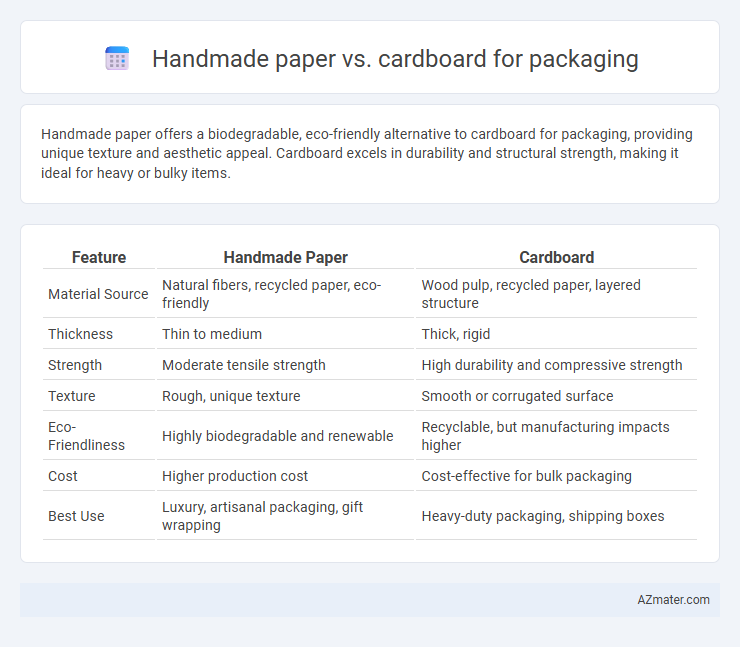Handmade paper offers a biodegradable, eco-friendly alternative to cardboard for packaging, providing unique texture and aesthetic appeal. Cardboard excels in durability and structural strength, making it ideal for heavy or bulky items.
Table of Comparison
| Feature | Handmade Paper | Cardboard |
|---|---|---|
| Material Source | Natural fibers, recycled paper, eco-friendly | Wood pulp, recycled paper, layered structure |
| Thickness | Thin to medium | Thick, rigid |
| Strength | Moderate tensile strength | High durability and compressive strength |
| Texture | Rough, unique texture | Smooth or corrugated surface |
| Eco-Friendliness | Highly biodegradable and renewable | Recyclable, but manufacturing impacts higher |
| Cost | Higher production cost | Cost-effective for bulk packaging |
| Best Use | Luxury, artisanal packaging, gift wrapping | Heavy-duty packaging, shipping boxes |
Introduction to Handmade Paper and Cardboard in Packaging
Handmade paper is crafted through traditional methods using natural fibers, offering eco-friendly and biodegradable packaging with a unique texture and aesthetic appeal. Cardboard, typically produced from recycled paper pulp, provides sturdy and durable packaging solutions capable of protecting heavy or fragile items during shipping. Both materials serve distinct purposes in packaging, with handmade paper favored for luxury and sustainable packaging, while cardboard excels in structural support and mass production.
Key Differences Between Handmade Paper and Cardboard
Handmade paper features a unique texture, superior absorbency, and is usually made from natural fibers through an artisanal process, making it eco-friendly and aesthetically distinct. Cardboard, typically produced from wood pulp, offers higher durability, rigidity, and cushioning, suitable for protecting heavier items during shipping. While handmade paper emphasizes artistic appeal and sustainability, cardboard prioritizes strength and functionality in packaging applications.
Sustainability and Environmental Impact Comparison
Handmade paper offers a more sustainable option for packaging due to its use of natural fibers and minimal chemical processing, resulting in lower energy consumption and reduced carbon footprint compared to traditional cardboard manufacturing. Cardboard, while widely recycled, often relies on industrial processes and a higher volume of raw materials, contributing to deforestation and greater landfill waste when not properly disposed of. Choosing handmade paper packaging supports eco-friendly practices by promoting biodegradability and encouraging the use of recycled or upcycled materials, thus reducing overall environmental impact.
Strength and Durability: Handmade Paper vs Cardboard
Handmade paper offers unique texture and eco-friendly appeal but generally lacks the strength and durability of cardboard, which is engineered for heavy-duty packaging needs. Cardboard's multi-layered structure provides superior resistance to crushing, tearing, and moisture, making it ideal for protecting fragile or heavy items during transit. While handmade paper suits lightweight, decorative packaging, cardboard remains the preferred choice where robustness and longevity are critical.
Aesthetic Appeal and Design Flexibility
Handmade paper offers a unique, textured surface ideal for luxury packaging, providing exceptional aesthetic appeal with its natural fibers and artisanal look. Cardboard supports versatile design options due to its structural rigidity, enabling customized shapes, embossing, and vibrant prints for eye-catching packaging. Combining handmade paper with cardboard layers enhances both visual elegance and design adaptability, creating premium packaging solutions.
Cost Considerations for Packaging Choices
Handmade paper tends to be more expensive than cardboard due to its labor-intensive production process and limited scalability, impacting overall packaging costs. Cardboard, produced via automated manufacturing with recycled materials, offers a cost-effective solution suitable for high-volume packaging needs. Businesses must weigh the premium cost of handmade paper against the budget-friendly and durable nature of cardboard when selecting sustainable packaging options.
Customization and Printability Options
Handmade paper offers unique textures and organic variability, enhancing customization through artisanal finishes and natural dyes, which appeal to luxury branding and eco-conscious consumers. Cardboard provides superior printability with smoother surfaces that support high-resolution graphics, vibrant colors, and detailed branding essential for mass production packaging. Both materials enable tailored packaging solutions, but handmade paper excels in bespoke, tactile experiences while cardboard optimizes visual impact and consistency.
Eco-Friendly Branding: Consumer Perceptions
Handmade paper is favored for eco-friendly branding due to its biodegradable and recycled fiber content, appealing to environmentally conscious consumers seeking sustainable packaging options. Cardboard, while also recyclable, often involves higher energy consumption and chemical treatments in production, which can affect brand perception as less eco-friendly. Consumer preferences increasingly lean towards handmade paper packaging for its artisanal quality and reduced environmental footprint, enhancing brand authenticity and eco-conscious market positioning.
Ideal Use Cases for Handmade Paper Packaging
Handmade paper packaging excels in luxury and eco-friendly product presentations due to its unique texture and sustainable nature, making it ideal for boutique cosmetics, artisanal foods, and specialty gift wrapping. Its biodegradable and recyclable properties cater to brands emphasizing environmental responsibility and zero-waste goals. Compared to cardboard, handmade paper offers superior aesthetic appeal and a handcrafted touch that enhances brand value in niche markets.
When to Choose Cardboard for Packaging Solutions
Cardboard is ideal for packaging when durability and protection are paramount, especially for shipping heavy or fragile items. Its strength and rigidity provide superior cushioning against impacts, moisture resistance, and stackability during transportation and storage. Businesses requiring cost-effective, recyclable, and customizable packaging solutions often choose cardboard to ensure product safety and sustainability.

Infographic: Handmade paper vs Cardboard for Packaging
 azmater.com
azmater.com